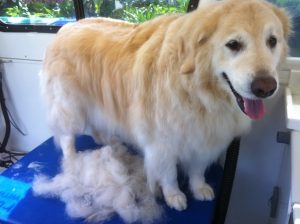Dogs & Shedding Hair
Shedding is a normal part of a dog’s life. As professional dog groomers, we deal with normal hair loss and seasonal shedding on a regular basis. But it’s important to realize that shedding can occur for other reasons as well. Here’s an overview of the top reasons your dog may be shedding hair.

Normal Hair Loss & Seasonal Shedding
Dogs and shedding go hand in hand. For all breeds, a normal amount of hair loss is simply a fact of life. Hair grows constantly, and some constantly falls out. Your groomer can advise the best type of tool to use for daily brushing to keep shedding under control. Thick-coated breeds may experience periods of heavier shedding when the seasons change.
Think your dog doesn’t shed? Some types of dogs appear to shed very little, and are often recommended to people whose allergies cannot tolerate the loose hair and dander associated with most breeds. It’s important to understand, however, that these “non-shedding” dogs – such as poodles and wheaton terriers – still have hairs falling out just like other dogs. It’s just that you don’t notice the shedding in these breeds because most of the loose strands are caught and held by the other hair in the coat that is still attached to the dog. With a non-shedding breed, you may not have dog hair floating around all over your house, but you will have to brush your dog regularly, to keep the loose hairs that are caught in the coat from turning into painful, unsightly mats.
Hair Loss During Pregnancy and Lactation
Pregnant and/or nursing dogs frequently “blow their coat,” or lose shocking amounts of hair rapidly. Hormone changes during pregnancy and lactation can cause a dog’s hair to stop growing and enter a dormant phase. Hair in such a resting phase is more easily shed than that which is actively growing. Thankfully, the dog’s coat should return to normal once her hormones settle down.

Hair Loss Due to Flea Allergies
Flea bites will make your dog itch, but they may also cause him to lose large amounts of hair. Dogs bite or scratch their skin to quell the itching caused by flea bites, and animals who are actually allergic to fleas often lose a lot of hair in their most flea-infested areas. In these situations, your veterinarian may prescribe a course of mild oral steroids to reduce the inflammation and allow the skin and hair follicles to heal.
Other Serious Health Issues
Bald patches accompanied by biting, chewing, scratching, and/or a dull, brittle coat are all warning signs that your dog’s hair loss is abnormal and may be symptomatic of a medical problem. Hair that falls out in clumps or patches often indicates mange, particularly if the underlying skin is hot, red and inflamed. Hair loss is a symptom of Cushing’s disease, and ringworm also causes canine hair loss. These are all serious health problems that require a veterinarian’s care, so make your dog an appointment as soon as symptoms appear.
One of the benefits of seeing a professional groomer regularly is that you’ll have the benefit of an extra pair of eyes and hands on your pet. We’ll always let you know if we notice anything unusual or out of the ordinary.
